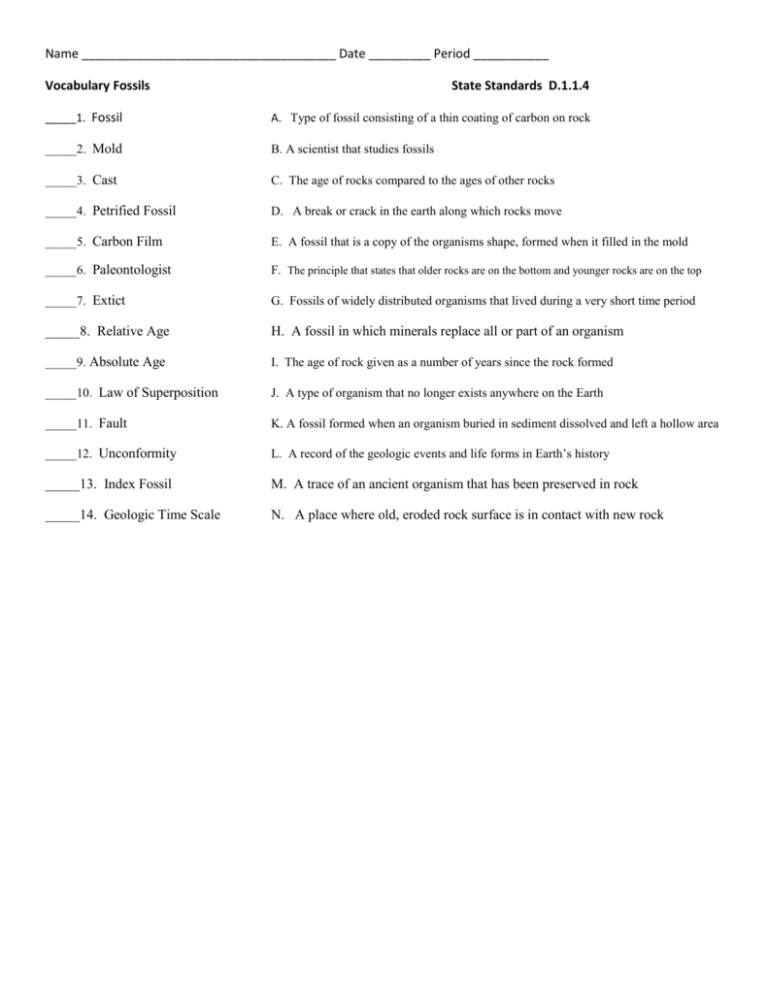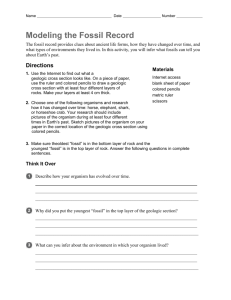fossil review
advertisement

Name _____________________________________ Date _________ Period ___________ Vocabulary Fossils State Standards D.1.1.4 _____1. Fossil A. Type of fossil consisting of a thin coating of carbon on rock _____2. Mold B. A scientist that studies fossils _____3. Cast C. The age of rocks compared to the ages of other rocks _____4. Petrified Fossil D. A break or crack in the earth along which rocks move _____5. Carbon Film E. A fossil that is a copy of the organisms shape, formed when it filled in the mold _____6. Paleontologist F. The principle that states that older rocks are on the bottom and younger rocks are on the top _____7. Extict G. Fossils of widely distributed organisms that lived during a very short time period _____8. Relative Age H. A fossil in which minerals replace all or part of an organism _____9. Absolute Age I. The age of rock given as a number of years since the rock formed _____10. Law of Superposition J. A type of organism that no longer exists anywhere on the Earth _____11. Fault K. A fossil formed when an organism buried in sediment dissolved and left a hollow area _____12. Unconformity L. A record of the geologic events and life forms in Earth’s history _____13. Index Fossil M. A trace of an ancient organism that has been preserved in rock _____14. Geologic Time Scale N. A place where old, eroded rock surface is in contact with new rock Name _____________________________________ Date _________ Period ___________ Vocabulary Practice—Fossils Fossil Paleontologist Law of Superposition State Standards D.1.1.4 Mold Cast Extinct Relative Age Unconformity Petrified Fossil Absolute Age Index Fossil Carbon Film Fault Geologic Time Scale 1. This type of fossil consisting of a thin coating of carbon on rock is called a ______________________ 2. A place where old, eroded rock surface is in contact with new rock is called an _____________________. 3. The ____________ ___________is when you compare age of rocks to the ages of other rocks surrounding it. 4. A __________________ is a break or crack in the earth along which rocks move. 5. A ________________ is a trace of an ancient organism that has been preserved in rock. 6. A ______________ is a fossil that is a copy of the organisms shape which formed when it filled in the mold 7. A fossil formed when an organism buried in sediment dissolved and left a hollow area is called a _____________. 8. An _________________ organism is an organism that no longer exists anywhere on the Earth. 9. Fossils of widely distributed organisms that lived during a very short time period are called ___________ ___________. 10. A_____________ __________ is a fossil in which minerals replace all or part of an organism 11. The _____________________________ is a record of the geologic events and life forms in Earth’s history 12. The _____________________________ is the principle that states that older rocks are on the bottom and younger rocks are on the top. 13. _______________________________ is when the age of rock given as a number of years since the rock formed. 14. A scientist who studies fossils are ____________________________________.





![F3-4 Study Guide for QUIZ [1/28/2016]](http://s3.studylib.net/store/data/006814899_1-56a576b1a51c0f876f28a8da0f15de89-300x300.png)

